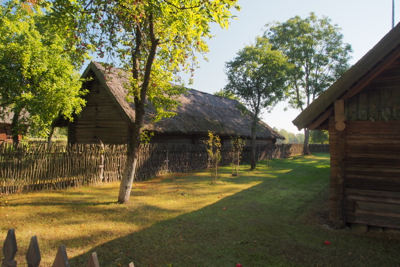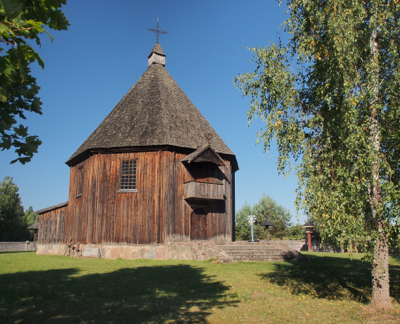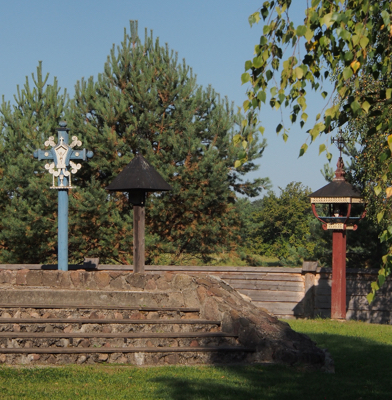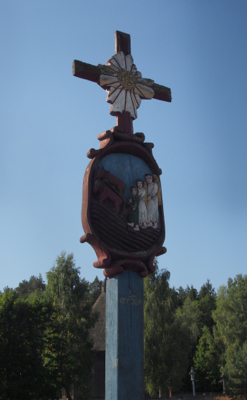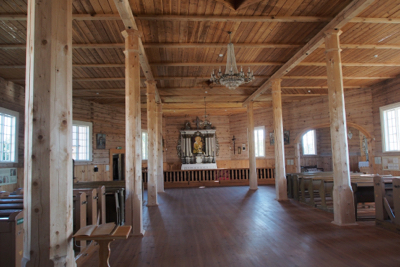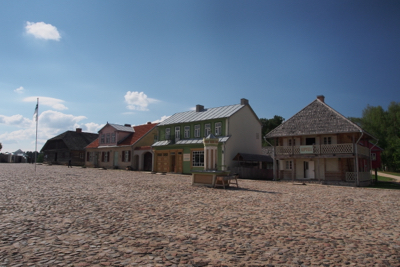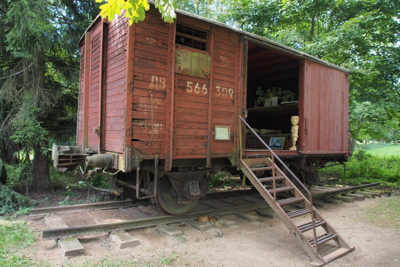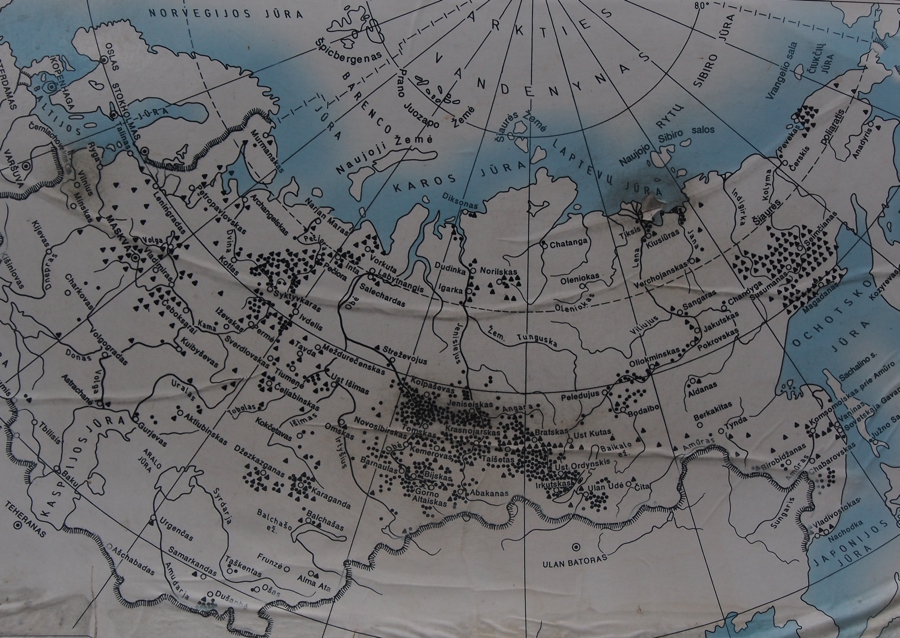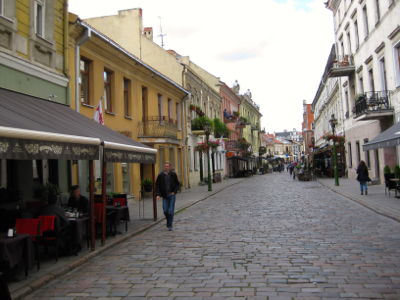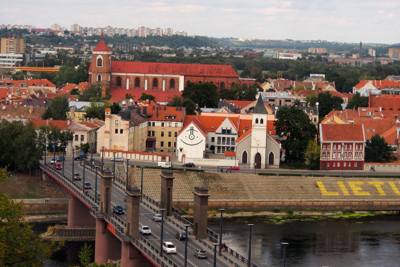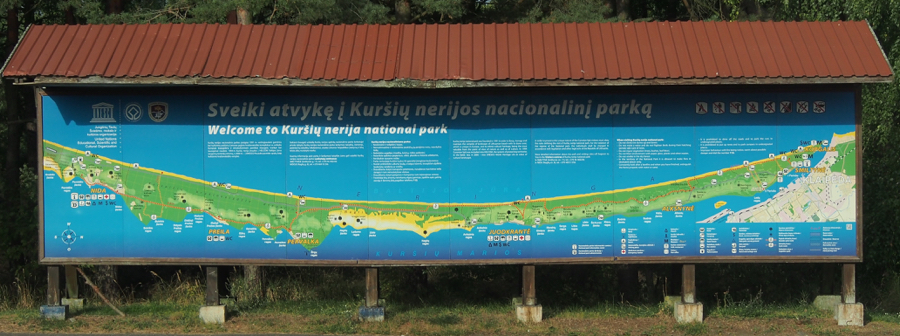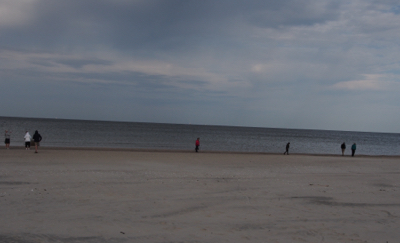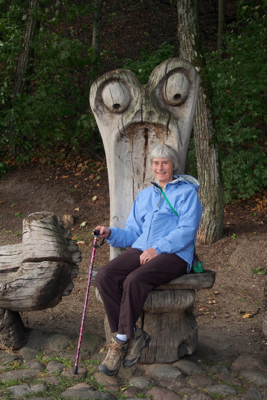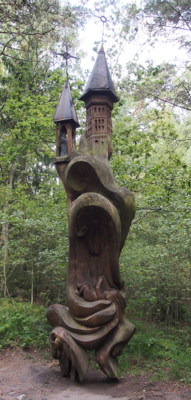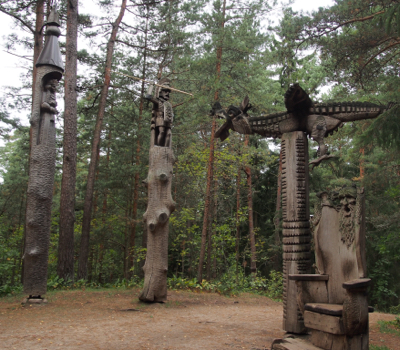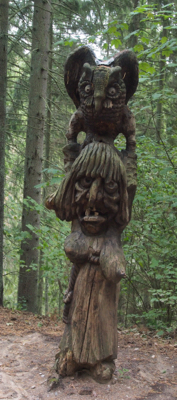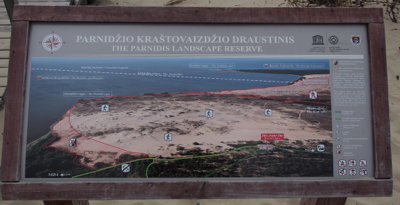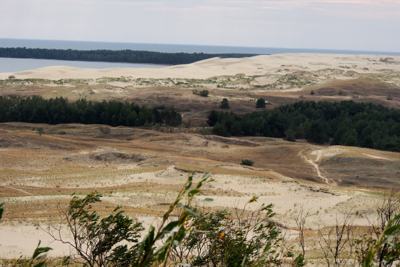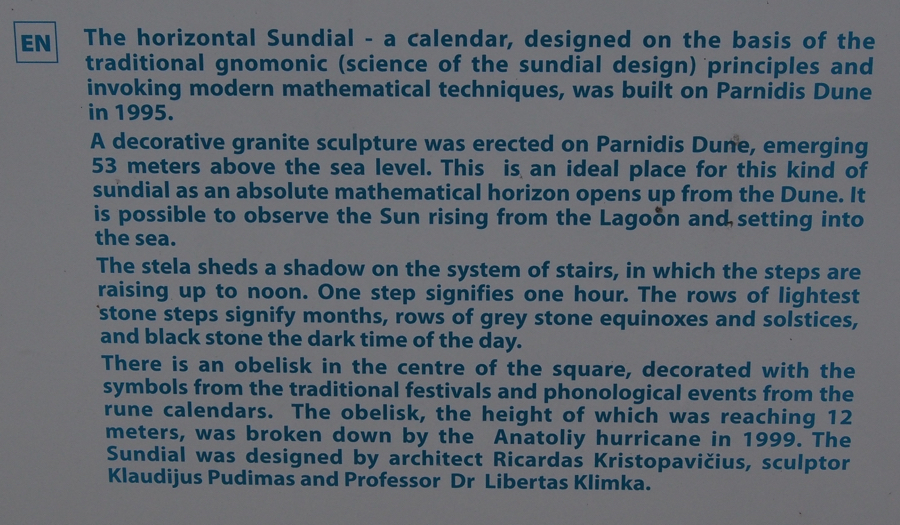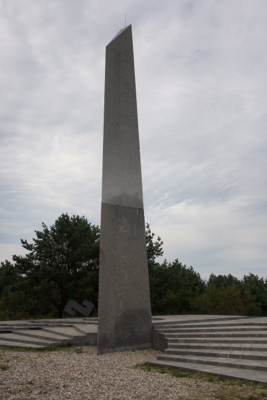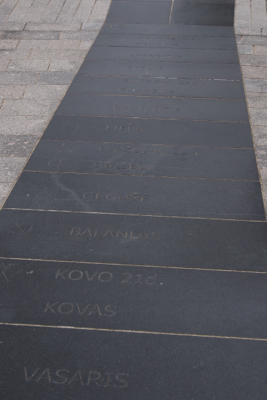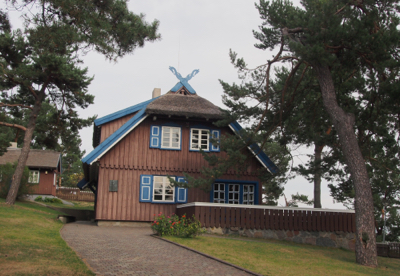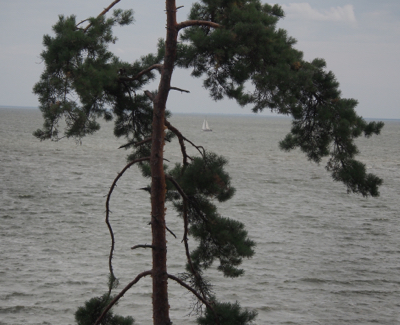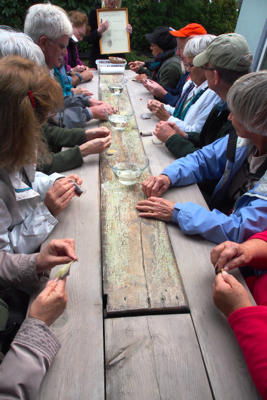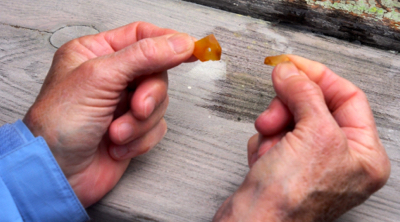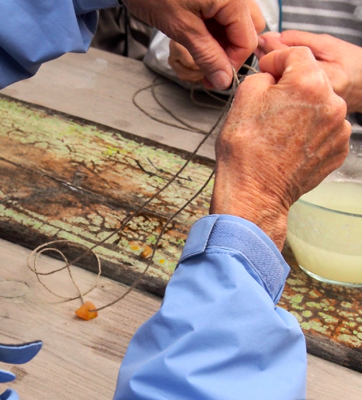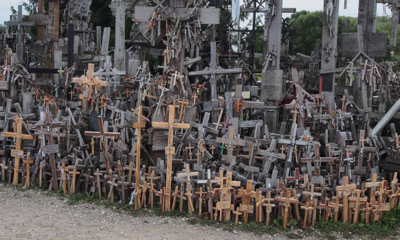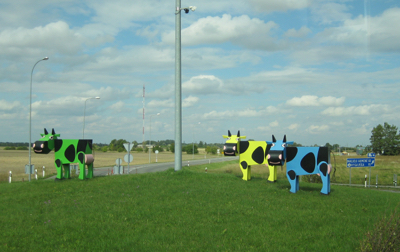Fri., 9/11/15 – Vilnius to Klaipeda, Lithuania
We left Vilnius at 9:15 and headed toward Klaipeda where we will stay for two nights. To break up the day of driving we stopped at the Rumskiskes Open Air Museum of 19th c. life in Lithuania. One hundred and fifty buildings representing the five ethnic regions of Lithuania have been moved to a large park outside of Kaupus, the second largest city and capital between the times of the two World Wars. We took the auto route around the park and stopped to visit three farmhouses representing a large wealthy house (a 60 acre farm), a middle sized house (30 acres) and a poor farm (10 acres). The three floor plans were similar, each with three sections: an entry room in the middle, a guest room to the left and the family room to the right. The family room has a large oven, two beds – one for grandparents and one for the farmer and his wife – while the kids slept on straw on the floor in winter and in storage barns in summer, and a large kitchen table with benches. Our museum guide showed us several functional devices used in these 19th c. houses.
We drove on to a lowlands, prosperous 1866 farmhouse with 160 acres and more barns and houses for the hired farm hands. This house had a summer kitchen and two bedrooms in addition to the family room.
Next we stopped at a reconstructed village with a cobblestone square, RC Church, schoolhouse, bar, hardware store, craftsmen, and stable with 20th c. carriages. The church was particularly interesting because it was mostly undecorated but with an attractive timber construction.
Rumsiskes Open-Air Museum
Rumsiskes Open-Air Museum - Octagonal Church
Rumsiskes Open-Air Museum - Chapel posts
Rumsiskes Open-Air Museum - Chapel posts
Rumsiskes Open-Air Museum - Roman Catholic Church
Rumsiskes Open-Air Museum - Roman Catholic Church
Rumsiskes Open-Air Museum - Re-constructed village square
Included with the other exhibits was an area depicting the deportation of Luthuanians to Siberia during the Soviet Occupation. It contained a cattle car like the ones used to transport people to Siberia. Seventy people were crammed into the car for one or two months. The train stopped every three days and they were given one bucket of water for the whole group. A hole was cut in the floor to be used as a potty.
There was also a Siberian structure that served as a house for 40 people. It was made of permafrost sod and driftwood from Lake Baikal. Inside were shelves for sleeping and nothing much else.
Rail car used for deportations to Siberia
Typical “house” for Lithuanians in Siberia
Locations of Lithuanians deported to Siberia
We met a woman, Rue, who is the subject of the book, “Between Shades of Gray.” She was among the first to be deported from Lithuania on June 14, 1941. These deportees were intellectuals and Lithuanian army officers. Rue’s father was an officer, and her mother, 16-year-old brother, and Rue - at age 14 - were taken to southern Siberia, arriving after one month on the train. Her father and brother were separated from the women. After one year in the south, she was sent to Northern Siberia at the delta of a river that feeds a lake. It took two months in a cattle car to get there. The temperature ranged from -86° to +4° centigrade and it snowed for 11 months. They lived in the sod houses they built. The Lithuanians were forced to fish in the delta but could not keep any of the fish they caught. They were paid three rubles a day but a kg of bread cost 4.6 rubles. In order to survive, they learned to steal or finagle. This went on for six more years. After 17 years Rue was able to find her way back to Lithuania, even though deportees were not “allowed” to return. Rue is now 87-years-old. She was able to marry, had a daughter who had two kids and now she has a great-grand child. It is a very sobering but impressive story she tells. She is a spry, little, determined woman.
We drove in to the town of Kaunas for lunch. Kaunas is the second largest city in Lithuania and was the capital during the years of prosperity between the two world wars when Lithuania was an independent country. We ate lunch in the cellars of the Avilys Beer Brewery and had soup, turkey, rice and vegetables, and ice cream with raspberry sauce. It was a lot of food.
We had a half-hour to walk the cobbled pedestrian street in the old town.
Before leaving Kaunas our bus drove us to an overlook. We looked down on the city and the confluence of the two longest Lithuanian rivers.
Main street of Kaunas
Kaunas from the overlook
Sat., 9/12/15 – Klaipeda, the Curonian Spit, and the Hill of Witches
This morning our bus got on a ferry to cross the lagoon from Klaipeda to the Curonian Spit. The sand spit is 99.9 km long and one third is in Lithuania (the port we visited) and two-thirds belongs to Kaliningrad, which is Russian. The spit has dunes on both the lagoon and the Baltic Sea sides.
At our first stop our local guide, Sigrit, took us on to the Baltic Sea white sand beach to look for amber. Amber is prehistoric pine resin from the tropical forest that is now covered by the Baltic Sea. The amber washes up onto the beach but divers also get larger pieces from under the sea. We walked along near the water line and picked up small pieces of yellow amber. It was a fun discovery. The Lithuanian part of the spit is all National Forest but amber collecting is legal and very popular.
Map of the Curonian Spit
Searching for amber on the beach
Jellyfish on the beach
Amber
We drove through the forest of tall pine trees looking for the moose and wild boar that inhabit the forest – we did not see any. Our next stop was in the town of Juodkrante where we walked the Hill of Witches. In 1979 while under Soviet control, wood carvers were encouraged to carve oak tree trunks into Lithuanian fairy tale characters. There are 80 carvings. Sigrit led our group up and over the hill and told us the fairy tales connected with many of the carvings.
Gale at the Hill of Witches
Hill of Witches
Hill of Witches
Hill of Witches
Hill of Witches
Lunch restaurant in Preila
At Nida and the border with Russia, we walked to the top of the dunes near the Lithuanian/Russian border and looked out into the Russian territory. At the top of the dune is an interesting sundial and lunar calendar. We did not have time to figure it all out.
Russia in the distance
Russia in the distance
Sundial and lunar calendar
Sundial and lunar calendar
Nida became a popular place for artists to be inspired. In 1929 to 1930, Thomas Mann lived and wrote in his house in Nida. The house is now a museum. One artist in Nida decided to try to preserve some of the local past by collecting and restoring pre-Christian “plank crosses,” Curonian fishing boats with flat keels (because the lagoon is so shallow), and weather vanes.
Thomas Mann's house
Sailboat
Weather vanes
We spent time at an Amber Museum and Shop where we learned more about amber.
After our lecture we sat outside and were given a nickel sized piece of amber to polish and make into a necklace pendent. We rubbed the stone on emery paper – horizontal, then vertical, and last in circles – to remove the “skin” and reveal the shiny amber beneath. We tied it on a string and wore our new jewelry.
Making an amber necklace
Making an amber necklace
Making an amber necklace
Sun., 9/13/15 – Kleipeda to Riga, Latvia
We drove all morning before stopping for lunch in Siauliai. After lunch, we went the short distance to the Hill of Crosses. There are several stories as to how the hill began but it now has thousands of crosses. At one time people erected a cross for a person sent to Siberia who never returned. But for 25 years during the Soviet period the crosses were bulldozed down and guards prevented anyone from putting up more. Now people come from all over to leave a cross in memory of someone, or for an up coming wedding, or illness or anything. It is a massive pile of wooden crosses of all sizes. John Paul II put a large cross at the beginning of the hill.
Hill of Crosses
Hill of Crosses
Hill of Crosses
Interesting entry to some town!
| Return to Top | Return to Itinerary | Return to Trips page to view other trips | Return to Dreamcatcher Home Page |
